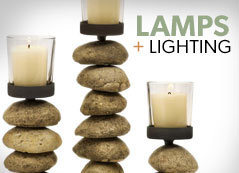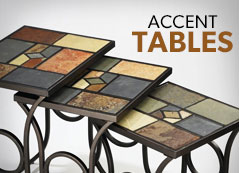
Lamps
Decorative lamps and lighting accent the beauty of any room in your home and will serve you with so many functions! Decorative lights can also add to the aesthetic and architectural appeal of the surroundings that it is put into. Your lamp is a replaceable component such as an incandescent light bulb, which is designed to produce light from electricity. These components usually have a ceramic or metal base, which makes an electrical connection in the socket of a light fixture. This article will focus on home lamps and its many uses.
Things to Consider:
Before You Buy a table lamp you will need to consider such things as size of the lamp, height, proportions, weight, watts of the bulb, style, and material. Most people who buy a lamp will just go into a lighting store and pick out the table lamp that looks most appealing or best for them. But it is important to think about what a buyers needs are for a lamp. Before you buy you must consider style, scale, wattage and function! Here are some tips that should help you get started.
For size, if you're using the lamp for ambient or general light or as a decorative accent, almost any size will do. If you intend to use your lamp for reading, make sure it's big enough to cast light on the area where the reader will be sitting. There's nothing more frustrating than trying to read by the light of a tiny ornamental lamp. With height, if the lamp rest next to a chair or sofa, by rule, the bottom of the shade should be level with the ear of the seated person to prevent the bulb from shining in their eyes. Before you go to buy a lamp you should measure the height of the table the lamp will be sitting on, along with the distance from the floor to your ear, and bring those measurements when you so you'll by the right lamp. It is important to have your lamp proportioned to the table on which it will be sitting. You don't want the shade to extend beyond the edges of the tabletop. Conversely, you don't want the lamp so small that it looks tiny on the tabletop. Another important step to take when purchasing your lamp is to check the Weight of it. You should pick up the lamp and see if the base is weighted. A heavy base won't be knocked over as easily which is something to consider if you have young children or the lamp that is located in a place where it could get knocked over. As a rule, the cheaper the lamp, the less the base will weigh. As for bulb watts, reading lamps should produce at least 100 watts of light. Since most single-socket on/off lamps take a 60-watt light bulb at most, is it best to choose a fixture that holds a three-way bulb instead. For material, try to pick a lamp base that complements your room and decor. The shade is just as crucial to a lamp's great look as the base.
Quick history:
The first lamp was invented around 70,000 BC. The word lamp is derived from the Greek word lampas, meaning torch. The different types of lamps before today's electric lamps were Oil Lamps which were used in the 18th century. Early lighting fuels consisted of olive oil, beeswax, fish oil, whale oil, sesame oil, nut oil, and similar substances. In 1859, drilling for petroleum oil began and the kerosene lamp grew popular, first introduced in 1853 in Germany. Coal and natural gas lamps were also becoming wide-spread. Coal gas was first used as a lighting fuel as early as 1784. Early in the 19th century, most cities in the United States and Europe had streets that were gaslight. Gas lighting for streets gave way to low pressure sodium and high pressure mercury lighting in the 1930s and the development of the electric lighting at the turn of the 19th century replaced gas lighting in homes.
The Incandescent Light bulb, contrary to popular belief, was not invented by Thomas Alva Edison, but rather he improved upon a 50-year-old idea. Two inventors that patented an incandescent light bulb before Thomas Edison did were Henry Woodward and Matthew Evan. Thomas Edison, who had been working on the same idea, bought the rights to their patent. Using a low electrical current, Edison successfully demonstrated the light bulb in 1879 and, as they say, the rest is history.
Different kinds of lighting bulbs:
Incandescent light bulb was the first type of modern electric light, introduced in the early 19th Century. The incandescent light bulb has been rated low at converting electricity to light because of energy waited in the process. This is because 90% of the electricity input is wasted as heat. This excess heat is then dumped into the air which, in warm climates, must then be cooled by ventilation or air conditioning, resulting in more energy wastage.
Next, Halogen lamps were introduced as an improvement to incandescent light. Visible light output of these lamps is about 15% of the energy input, allowing them to produce a total of about 50% more light using the same amount of electrical power. Good halogen bulbs produce a "cool white" color temperature approaching the appearance of sunlight at noon, while regular incandescent lights produce warm light with a warm yellow tint.
Fluorescent lamps have an efficiency in that they use 25% the power and produce 1/6 the heat of a regular incandescent. Fluorescents were limited to linear and a round circular lamp until the 1980s. Compact and linear fluorescent lamps last far longer than incandescent light, but do have some starting trouble in very cold weather when installed outside. Other types of lighting are the HID lamp which is used on lamps like floodlights and the LED lamps are what you will find in nightlights and flashlights.
Different types of lamps to choose from:
One of the most popular and beautiful lamps that can be put in your home is the Tiffany Lamp. A Tiffany lamp is a type of lamp with a stained glass shade. The pieces of stained glass that comprise a Tiffany shade are soldered together with copper foil. Original Tiffany lamps are generally considered part of the Art Nouveau movement, and are considered one of the best American contributions to this movement that began in Europe in the late 19th century. The first Tiffany lamp was created in 1899 with a bronze base and was designed by Louis Comfort Tiffany. The record price for an original Tiffany Studios lamp at a public sale exceeds 2 million dollars. Tiffany Lamps are also popular hanged like you would find in billiard lighting. Today there are many companies producing Tiffany-style lamps in an enormous range of designs at a much more affordable cost.
Floor Lamps are great for many rooms in the house. When choosing a floor lamp, choose one that is best for your style and the kind of light you want to have in the room during the day and at night. Floor lamps come in all matter of shapes, sizes and colors. You have numerous choices about style and materials. They also come with choices of light bulbs, incandescent, fluorescent, and halogen. You can choose from styles such as traditional, contemporary, Asian, Spanish, Mexican, English Country, Italian, Mediterranean, Swedish, Victorian, and Vintage. When choosing your lamp, remember, you can choose a table lamp, floor lamp or a combination. Next you are going to want to choose the size of lamp you want.
Also you will have to consider the color you want the lamp to be and what type of material you want for the shade and the body of the lamp.
Table lamps should satisfy lighting requirements as well as complement your room's decor. Here are some ways to make sure your lamp measures up. Choose a lamp of an appropriate size. A roomy end table or bombé chest can accommodate a more bulky lamp. Also consider the lamp's style. A high-tech swing-arm lamp will look out of place on a carved antique Victorian table.
Besides these other beautiful lamps, you can also express yourself with a novelty accent table lamp. They're a great way to add personality and detail to a room décor, or to add a charming touch to a child's room. There are a wide range of novelty lamps and lighting designs. Try an accent light on a side table to brighten a hallway. For family movie time a novelty lamp can provide a fun and functional light source. Novelty lighting makes a great gift for birthdays and holidays.
Whether it's a decorative accent novelty lamp or a functional night light or book light, there are a wide range of products to meet your needs. Novelty lamps can include lamps shaped as my different type of characters from popular entertainment sources and they also represent animal figures, etc. Lava and volcano motion lamps and very popular novelty lamps as well. You can use a novelty lamp along with a table lamp, floor lamp, or just by itself to help accent your room.
Lighting Your Home
Because your home's appeal will be elevated when properly illuminated, the right light fixtures in every room is vital. You may be facing some challenges during the home renovation process. For bathroom lighting, you will have your rooms lighting fixtures which will be great general lighting but a small lamp is great in aiding with things like shaving, grooming and applying make-up. Good kitchen lighting fixtures can avoid accidents and cooking mistakes so you'll want the best possible lighting solutions for your home. Lamps are great in the kitchen to highlight cooking needs, etc. For the other rooms in your house, like your bedrooms, living room, family room, and office, table and floor lamps will add great light and style to any room they are placed in. Use them to best highlight areas of use in your room and also use them to add to the functionality of the room.
Conclusion
Decorative lamps and lighting will accent the beauty of any room or landscape at any home! Your lamps will serve you in so many functions! Decorative lights will add to the appeal of any room that it is put into. With so many styles, colors, and shapes to choose from, you are sure to find the perfect lighting for every room in your home!




























